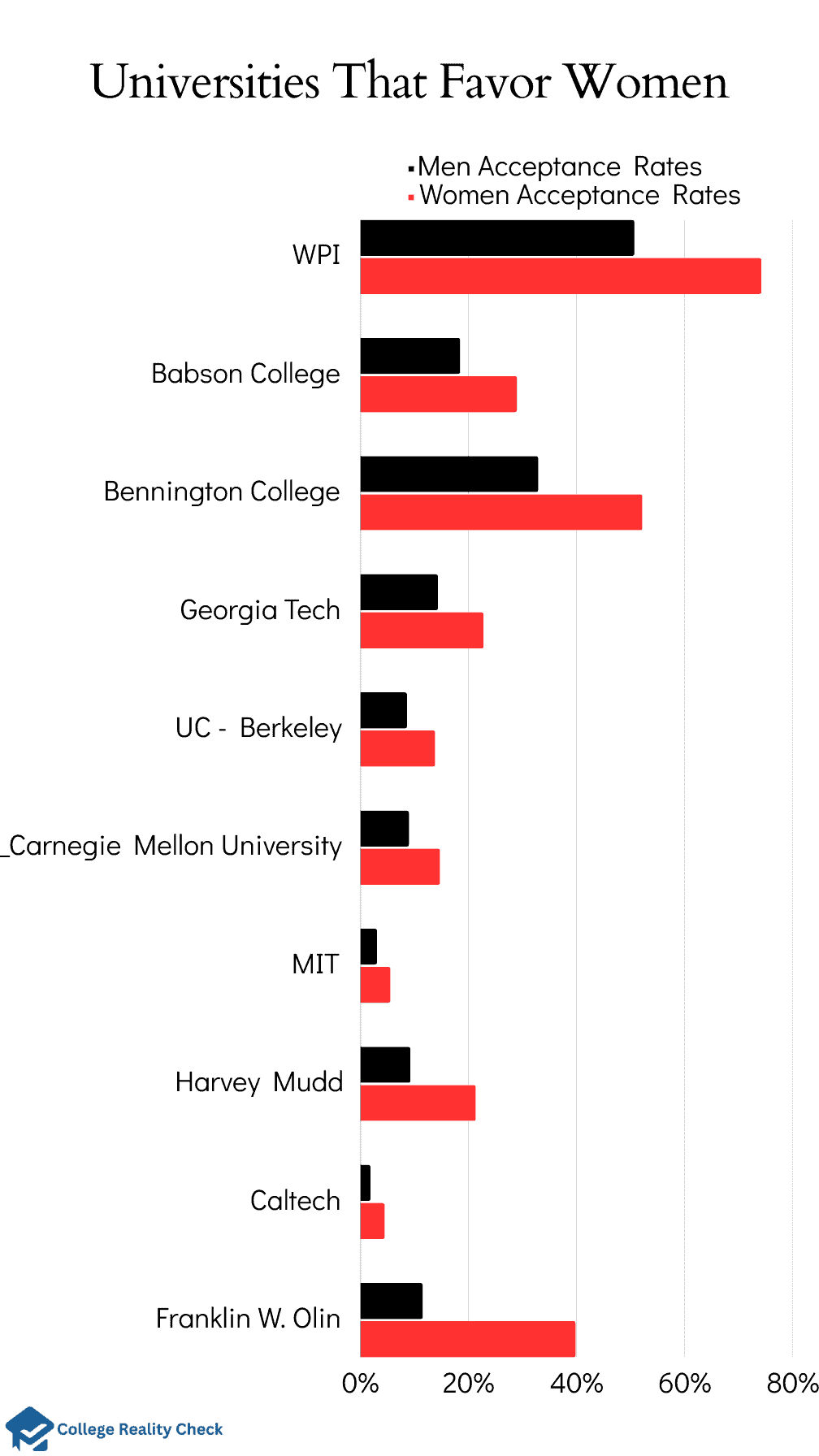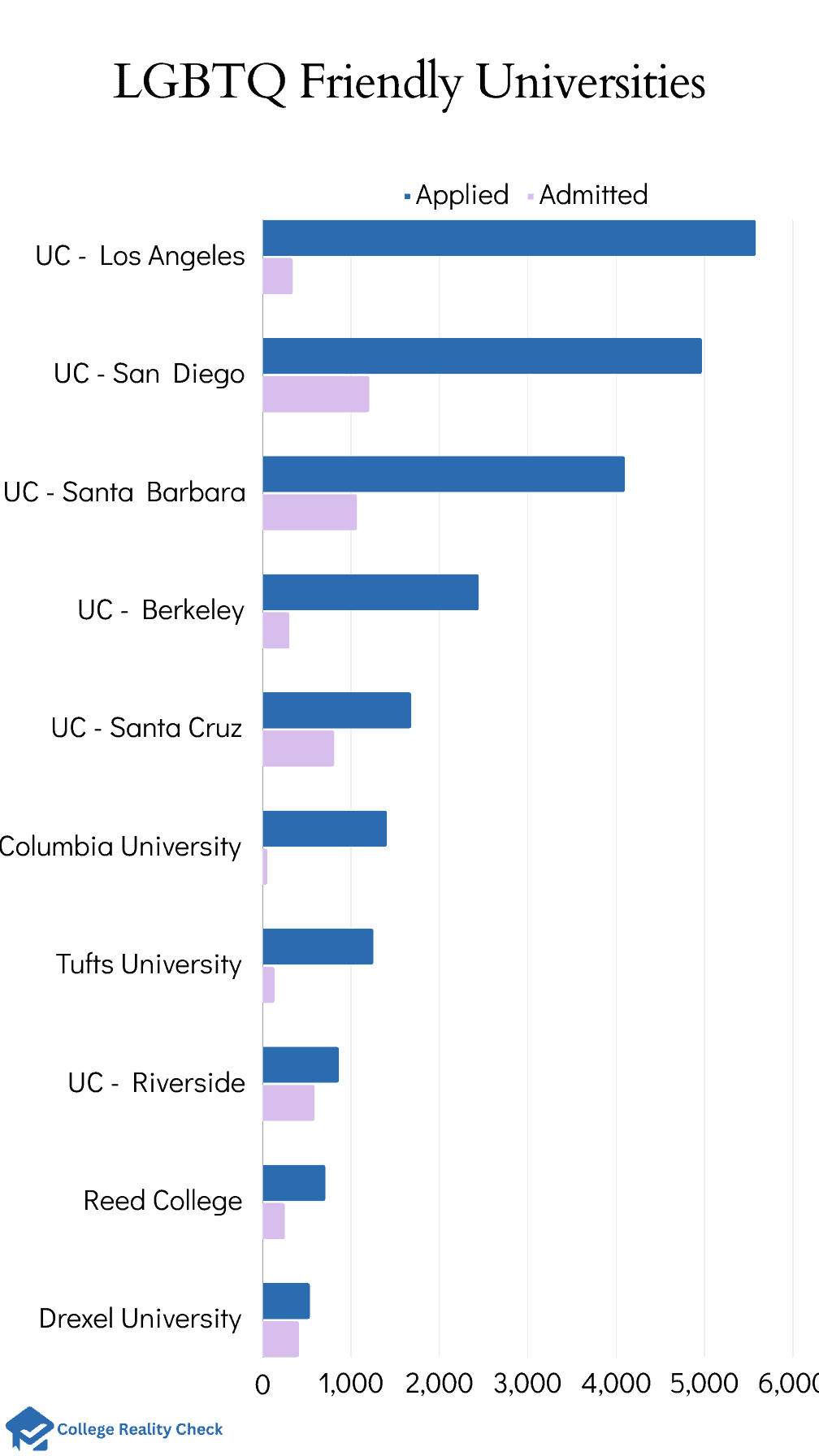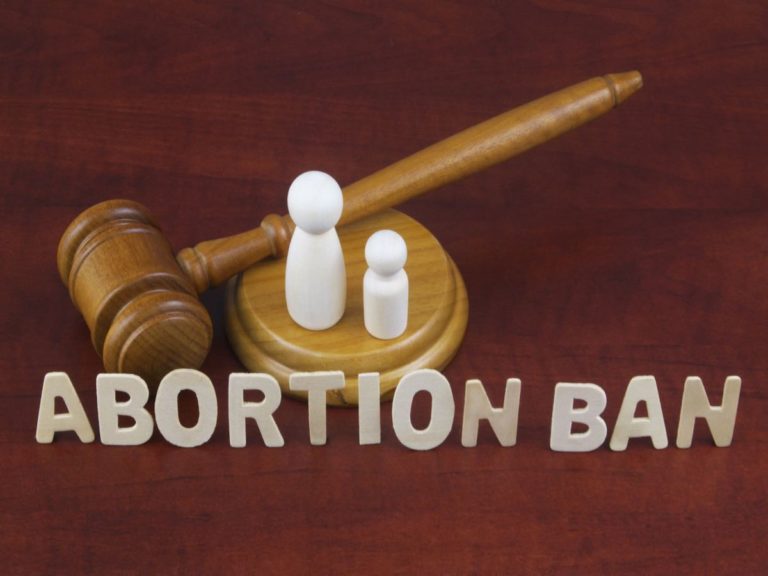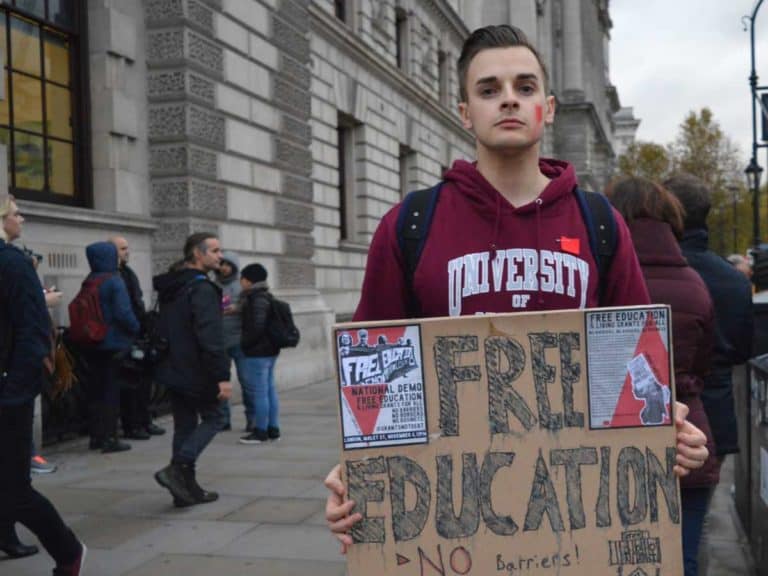Does Your Dream College Favor Men or Women? The Answer May Impact Your Admission Chances
Based on our analysis of the top 319 US universities, only 10% of colleges accept more men than women.
On the other hand, 48% favor women in admissions.
You can get the full dataset for free to check if your dream college favors students like you or the opposite gender.
Here are the 10 universities that strongly favor men:

Here are the 10 universities that strongly favor women:

Do you see the trends?
Universities that favor men are mostly liberal arts colleges, and those that favor women are technical universities.
But what about other trends?
Gender Imbalance in Colleges and Gender Bias in Admissions
If you ask most college admission professionals, they believe it is getting harder for female applicants to be admitted into college than male applicants.
For instance, according to the Hechinger Report, it is harder for women to get in because fewer men apply to college now compared to a decade ago.
There were some interesting facts cited in the report:
- Brandeis accepted 44 percent of male applicants compared to 36 percent of female applicants.
- Women now comprise nearly 60 percent of enrollment in universities.
- Fifty years ago, the gender proportions were reversed.
- Many public institutions aren’t allowed to consider gender in admissions, especially in the states with affirmative action bans: California, Washington, Florida, Arizona, Michigan, Nebraska, New Hampshire, Oklahoma, and Idaho.
While it is unfair to admit one gender over another, there is a reason behind such practices.
Because so many more women than men apply to these liberal arts colleges, if an institution wants to have gender balance on campus, there’s not a lot you can do other than discriminate
Charles Deacon, dean of admission at Georgetown University
It is a rule of thumb that a 40/60 ratio is a sweet spot for the number of men and women on campus.
If either gender goes over 60 percent, both men and women are less likely to enroll.
And it makes sense.
When choosing a college, many young people consider their chances of finding a date.
So, some colleges (not all) try to seek a gender balance by actively recruiting certain groups, and they may even waitlist a female applicant while accepting a male applicant with a similar academic background.
Why are Fewer Men Going to College?
As noted above, the admission trend has changed from being male-dominated to female-dominated over the years.
But why?
Here are some of the reasons behind this phenomenon:
Underemployment is lower among men
Compared to college graduates overall, recent college graduates are more likely to be underemployed.
According to recent data, around 53% of recent college graduates are underemployed.
Being underemployed means working in jobs that typically do not require the possession of a college degree.
Some are unemployed, too — it usually takes fresh degree holders about half a year to find their first job.
But it’s important to note that underemployment among new college graduates is not exclusive to men.
If truth be told, things are worse for women.
Based on a report called The Permanent Detour: Underemployment’s Long-Term Effects on the Careers of College Grads, women are considerably more likely to be underemployed than men.
As a matter of fact, nearly 1 out of every 2 female college graduates are initially underemployed.
Meanwhile, more than 1 out of every 3 male college graduates, which accounts for 37% of them compared to 47% of women, are underemployed from the outset of their working careers.
Skilled trades dominated by men
Everyone knows that the skilled trades are dominated by men.
As a matter of fact, construction, which employs around 10,030,000 people across the said industry, is comprised of around 89% males.
Here are the blue-collar jobs that follow it:
- Mining (85% males)
- Oil and gas extraction (85% males)
- Quarrying (85% males)
- Transportation and utilities (75% males)
- Durable goods (74% males)
- Agriculture and related industries (72% males)
- Manufacturing (71% males)
- Wholesale trade (70% males)
- Non-durable goods (64% males)
On the flip side, only a handful of skilled trades employ more women, such as:
- Private households (88% females)
- Education and health services (75% females)
- Financial activities (52% females)
- Leisure and hospitality (51%)
With so many blue-collar jobs available to males that are largely dominated by them, too, it isn’t surprising that a lot of men find spending precious resources on a college degree unnecessary.
Military draft end contributed to reduction of male applicants
There was a point during the 1970s that contributed to the downtick of male students in postsecondary institutions in the country: the lifting of the military draft with the signing of the Paris Peace Accords.
During the Vietnam War, you see, many men enrolled in colleges to avoid enlistment for state service, though it did not completely result in deferments but only delays in conscription.
But then, on January 27, 1973, after 25 years, the end of the military draft was announced.
No sooner than it happened, the gender enrollment gap closed all of a sudden — with men no longer using college campuses as shields, gender in 4-year institutions gradually attained balance, which culminated sometime in the 80s.
SAT changes led to improved female scores
When it comes to SAT scores, male test-takers initially enjoyed slightly higher figures — they scored higher than female test-takers for the reading section and math section by a relative performance of 0.99 and 0.93, respectively.
However, when the College Board remodeled the SAT in 2016, things took a different turn altogether.
And in the class of 2017, the relative performance of girls rose, which coincided with a small increase in the college enrollment rates of females.
LGBTQ Admissions
The Common Data Set format traditionally had only ways to input information only for men and women.

Only recently was the format updated to include an additional column – Another Gender.
Even so, not all colleges collect and provide information about LGBTQ applicants. In my research, only 58 colleges out of 319 had such data.
You can download the entire list from the link at the bottom of this post.
When analyzing the acceptance rates for “another gender” students, I didn’t find any evidence of significant positive or negative bias in admissions.
How to Use This Information
College admissions is a very complicated process, and it may look largely unfair to the general public.
On the other hand, it is important to understand that universities, especially selective ones, strive to create a so-called balanced class.
This means accepting a tuba player with a 3.6 GPA over a straight-A student because the school needs to add people to its orchestra.
Or accepting a student interested in German because if they don’t, they have to close their German Studies program due to lack of interest.
Or accepting a male applicant over a female applicant because the school wants to have a gender balance in incoming class.
Depending on a student’s gender, they may have an edge or be disadvantaged in college admissions.
The most common examples of gender advantage are women applying to technical universities, e.g., Georgia Tech, or men applying to colleges with strong nursing programs.
When building a college list, knowing if a college has a gender bias is important when assessing acceptance chances.
In times when college applications are becoming more competitive, even small things such as a student’s gender can impact whether you get in or not.
Disclaimer: The views and opinions expressed in this article are those of the authors and do not necessarily represent those of the College Reality Check.






